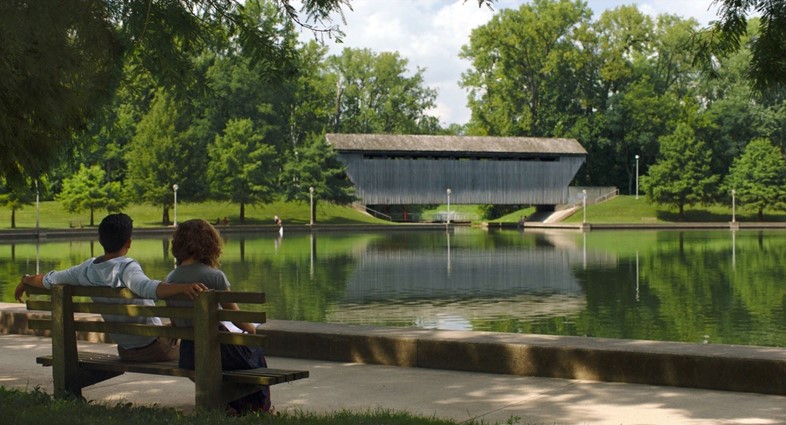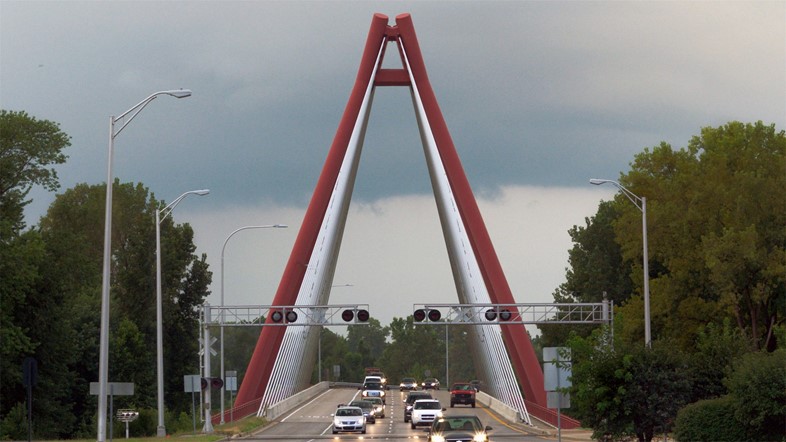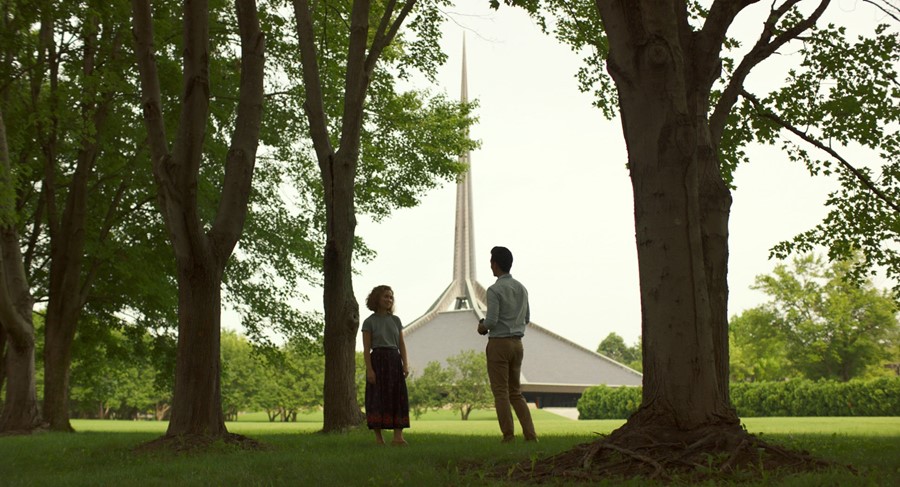Korean-American director Kogonada’s remarkable debut feature, Columbus, is a beautiful exploration of architecture, family and friendship, and the redemptive power of art
Korean-American director Kogonada discovered his love of cinema in his early twenties. “I had always enjoyed films,” he tells AnOther over the phone from his home in Los Angeles, “but that was when I realised that movies were more than just an escape, that some stayed with you long after leaving the theatre.” The types of films that struck him, he explains – from The 400 Blows to the work of Yasujirō Ozu – were “movies that were very fundamentally about what it means to be human, about finding our place in the world. I was struggling with a feeling of meaninglessness in my life, and I found these movies at the right time.” Ever since, Kogonada has devoted himself to “gaining a better sense of cinema” – first through his work as an academic and after as a filmmaker, creating short visual essays exploring the work and tropes of various well-known directors for the likes of the BFI and the Criterion Collection. Eventually, however, he itched to try his own hand at feature-length filmmaking, and began dreaming up what would become his highly accomplished debut, Columbus – a dreamy ode to human connection, modern architecture and the healing powers of art, which has just hit UK screens.
“I was working on a story about children and the burdens they feel with their parents,” Kogonada explains of the film’s inception, “both when you’re young and about to leave home, and when you’re older and you become aware that your parents may leave you permanently.” While loosely plotting ideas for a script, the director stumbled across an article about the small city of Columbus, Indiana, a hub of feted mid-century Modernist architecture. “I took a trip there with my wife and kids and immediately fell in love with it. It was enchanting and sad and beautiful, and struck me as somehow having its own narrative. It’s located in the middle of cornfields and you can definitely sense this belief in what design and architecture could do – that they can represent hope and comfort. I’ve always been moved by form and aesthetic, and I thought, ‘What if my movie could take place here?’ and it just really naturally became a part of that story.”

Columbus is the tale of two very different souls colliding against the backdrop of this lush, structurally rich city. Jin (John Cho), a Korean-American translator, is brought to Columbus by the news that his father, a renowned architecture scholar who was set to give a talk there, has fallen into a coma. He leaves his comfortable life in Seoul to take up reluctant residence in a bed and breakfast – a stunning, mahogany-panelled 1910 mansion, no less – until his father is well enough to travel. While traversing the city, he encounters Casey (Haley Lu Richardson), a young architecture fanatic who works in the local library. While Jin grudgingly inherited his knowledge of buildings from his professor father, Casey cultivated her love of form entirely from scratch, having grown up in a poor area of the city while caring for her recovering addict mother. What ensues is a quietly unfolding friendship between these two strangers, both of whom are struggling to reconcile their pasts with their presents, while looking uncertainly to the future. Their relationship develops through lengthy, Linklater-like discussions as the pair visit the city’s Modernist gems, quibbling over architecture’s ability to restore, sharing secrets and insecurities, and playfully teasing one another as their bond deepens.

The casting is impeccable – Richardson perfectly captures Casey’s passionate aesthetic curiosity and deep emotional empathy, while Cho strikes just the right balance of warmth and reserve, self-assurance and doubt – while brilliant support is offered by Posey Parker (as Jin’s father’s assistant), Michelle Forbes (as Casey’s caring but troubled mother) and Rory Culkin (as her brooding library cohort). But the buildings – from the majestic, colourfully decorated Miller House by Eero Saarinen, to the arresting North Christian Church (also Saarinen), with its stout hexagonal body and towering metal spire, to the red-brick Cleo Rogers Memorial Library by IM Pei – play equally important roles, their nuances and many facets, both visual and emotional, given just as much attention as the film’s human protagonists. Wide-angle exterior tableaux pay breathtaking homage to the concrete, glass and steel structures and the leafy nature that surrounds them – a key inspiration of the Modernist movement – while poetically realised interior shots depict the full power of the ordered geometry and striking use of natural materials and light employed by the mid-century modern pioneers.
The buildings lend a potent symbolism to the film, focused as it is on life’s temporal nature. Like Casey and Jin, the buildings have their own particular pasts that root them to one era and location, and yet they are laden with the utopian aspirations for the future with which their architects imbued them. “For me a sense of space and time is vital,” Koganada says on the subject, “because I’m not just moved by stories but I’m also moved by places and a feeling of time. Always, even as a little kid, that has moved me and created a kind of melancholy that feels important to me.” It is these qualities that Kogonada recognised in the work of the masters who first ignited his passion for film – and to whom he gently seems to tip his hat in Columbus through one-point perspective shots that echo Kubrick, for instance, and an ingenious one-take scene captured in the reflection of two mirrors (a hint of Bergman?) – and aroused in him an appreciation for visual forms and their redemptive capabilities.

This idea comes full circle in the character of Casey, who has recently had her eyes opened to the beauty of architecture, resulting in the dawning of a broader cultural and artistic awareness, which Kogonada says mirrors his own. “My parents were actually very creative when they lived in Korea, but that’s only something I realised much later because when we were growing up they were immigrants in America, trying to build a life for themselves and working all the time. My siblings and I kind of raised ourselves and we didn’t really have the resources to visit museums,” he explains. “In Casey, there’s definitely elements of me remembering myself when I woke up to not necessarily architecture at that moment but art forms. And once I became sensitised to one art form, I felt like I was sensitised to all art forms!” This awakening is something that Kogonada is particularly keen to propagate in this time of political turbulence. “I want art to be relevant, especially living in America where every day feels like madness to me,” he says. “A sense of beauty or even humanity, presented to us aesthetically – in a way that is not just about words, about intellectuality, but about feeling, something that can sensitise us as human beings – feels really important to me.” And there’s no doubt about it, both visually and thematically, Columbus is food for the soul.
Columbus is in cinemas nationwide now.
